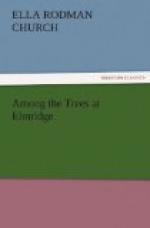“I don’t believe they’re very hot,” remarked Malcolm, who was puzzled over the bread-fruit tree himself, but who laughed at his little sister’s idea in a very knowing way. It was not an ill-natured laugh, though, and a glance from his governess always quieted him.
“No, dear,” replied Miss Harson, answering Clara; “loaves of bread do not grow on any tree. But I will tell you about the bread-fruit presently; let us finish the Morus family and their kindred in our own country before we go to their foreign relations. The Osage orange is so much used in the United States, and in this part of it, for hedges, on account of its rapid growth and ornamental appearance, that we really ought to know something about it. ’It is a beautiful low, spreading, round-headed tree with the port and splendor of an orange tree. Its oval, entire, polished leaves have the shining green of natives of warmer regions, and its curiously-tesselated, succulent compound fruit the size and golden color of an orange. It was first found in the country of the Osage Indians, from whom it gets its name, and it has since been cultivated in many parts of this country and in Europe. The Osages belonged to the Sioux, or Dacotah, tribe of Indians, and their home was in the south-western part of the old United States. The Osage orange—a tree from thirty to forty feet high with leaves even more bright and glossy than those of the ordinary orange—was first found growing wild near one of their villages.”
“But what a very high hedge it would make!” said Malcolm.
“Yes, if left to its natural growth, it would be a very absurd fence indeed. But this is not the case; the branches spread out very widely, and by cutting off the tops and trimming the remainder twice in a season a very handsome thickset hedge is produced, with lustrous leaves and sharp, straight thorns. Another name for this tree is yellow-wood, or bow-wood, because the wood is of a bright-yellow color, and the grain is so fine and elastic that the Southern Indians have been in the habit of using it to make their bows. The experiment of feeding silkworms upon the leaves has been tried, but it was not very successful.”
“I suppose the worms didn’t know that it belonged to the mulberry family,” said Clara, “and I don’t see now why it does.”
For reply, her governess read:
“’The sap of the young wood and of the leaves is milky and contains a large proportion of caoutchouc.’”
“Oh!” exclaimed Malcolm; “that sounds just like sneezing. What is it, Miss Harson?”
“Something that you wear on your feet and over your shoulders in wet weather; so now guess.”
“Overshoes!” replied Clara, in a great hurry.
“How many of them do you wear over your shoulders at once?” asked her brother. “And it must be a queer kind of sap that has overshoes in it. Why couldn’t you say ’India-rubber’?”
“And why couldn’t you say it before Clara put it into your head by saying ’Overshoes?” asked Miss Harson. “Clara has the right idea, only she did not express it in the clearest way. The sap of the caoutchouc, or India-rubber, tree is the most valuable yet discovered, and, as it is of a milky nature, it can very properly be brought into the present class of trees.”




